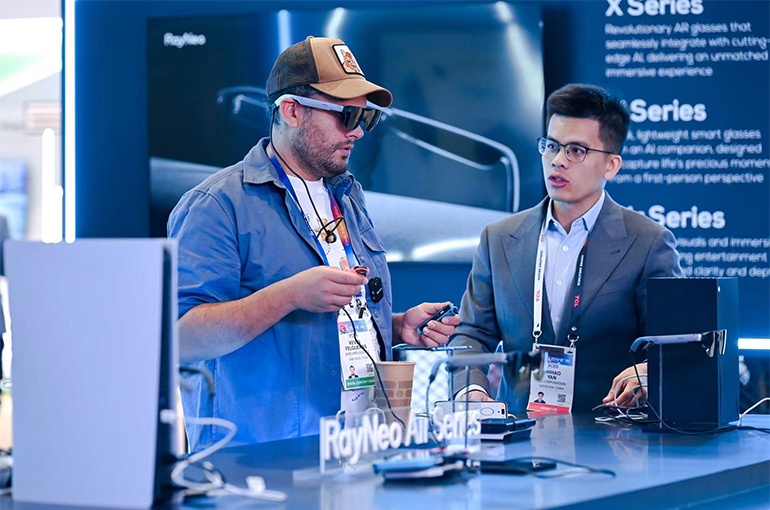 Chinese AR Glasses Makers Show Off New AI Gadgets at CES 2025
Chinese AR Glasses Makers Show Off New AI Gadgets at CES 2025(Yicai) Jan. 10 -- Chinese makers of augmented reality glasses have brought artificial intelligence-enabled glasses along to this year's Consumer Electronics Show. One of the most talked-about topics at the annual tech event, such products still face major development and adoption hurdles despite increasing consumer interest in smart glasses.
TCL-backed Thunderbird Innovation Technology launched its first AI photography glasses, the V3, priced at CNY1,799 (USD245) two days ago and put them on show at the CES in Las Vegas. The Shenzhen-based firm has allied with Alibaba Cloud, which in October 2023 brought out the large language model Tongyi Qianwen, also known as Qwen, on developing AI for smart glasses.
Hangzhou-based Rokid is also showcasing its Qwen-integrated AI Glass at the CES. The device, priced at CNY2,499 (USD350) and scheduled to launch next quarter, supports high-definition photo and video recording and offers customized lenses for users with myopia and astigmatism.
Thunderobot debuted its AI glasses with photo capabilities and AI model integration, with the Qingdao-based company also unveiling a more affordable AR glasses model priced at around CNY1,000 without camera and AI features.
Thundercomm, an Internet of Things unit of Beijing-based technology firm ThunderSoft, launched AI glasses that can connect to smartphones, featuring offline speech recognition algorithms and large language model connectivity.
AI smart glasses are on a rapid growth track, mainly because their functionality is relatively simple, they meet basic user needs such as photography, calling, and listening to music, and are relatively affordable, said Chen Jun, deputy general manager and chief analyst at Sigmaintell Consulting. These devices are one of the most discussed topics at CES this year, Chen added.
Last year, less than 20 percent of smart glasses had AI functions. In China this year, 60 percent are expected to, according to market researchers Runto. And global shipments may have doubled to 2.2 million units in 2024 and may increase to 3.5 million this year, according to Sigmaintell.
For smart glasses to become really popular gadgets, multiple technical challenges need to be overcome, including difficulties in mass-producing optical and display components, limitations in battery life and heat dissipation, and challenges related to AI computing power and algorithms, Runto analyst Wang Zishen told Yicai.
The current enthusiasm for AI glasses stems from their ability to free up users' hands while leveraging artificial intelligence, as evidenced by the overseas success of those from Ray-Ban and Meta, according to Wang.
Industry experts widely agree that the companies making smart glasses must innovate further in application scenarios and design aesthetics to meet consumer needs.
Editor: Martin Kadiev